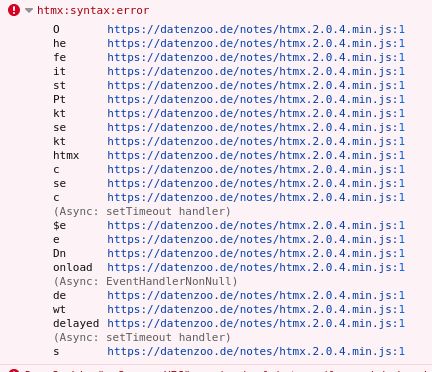I'm doing more stuff with HTMX.
HTMX allows for almost-convenient polling by adding hx-trigger="every 1s" to
an attribute. This allows you to kick off some processing on your server after
having served a page and automagically update the page with the status and
a download link when processing completes.
<div class="preview-card" id="preview-div"
hx-trigger="every 1s"
hx-get="/preview"
hx-swap="outerHTML"
>
Please stand by while we prepare your content
</div>
The polling only works if the element has a hx-get or hx-post attribute. It
does not work on <form> elements with action="..." , surprisingly.
The workaround is to add an explicit hx-get or hx-post="..." attribute
to the element:
<form method="POST" action="/submit"
hx-trigger="every 1s"
hx-post="/preview"
hx-swap="none"
>
<input name="message" type="text" />
...
</form>

I watched this movie in April or May 2025. The German title is Blood & Sinners,
while the US title seems to be just Sinners. Overall, the music is
entertaining, but I don't get the fawning reviews elsewhere.
I found the movie a bit aimless, and a hodgepodge of interesting ideas.
Overall, I think it has more promise than the movie realized. There are some
plots that don't go anywhere, which suggests to me that the script went through
several rewrites or is a combination of several other scripts.
The setting of the movie is the Deep South in the 1930s.
The population are: (Former) Slaves, (Irish) Whites, the token Asians.
Genre: Vampire Splatter Music Movie
Content-wise, the music gets short-changed. I saw this movie billed as a
musical, but to me, it is not. To me, a musical means that the song advances
the story and exposes some inner monologue of the actors, which does not happen
here at all. I've learned that the term of art is Book Musical. Polyphonic has
a treatise on Sinners,
and from there it could fall under the type of Backstage Musical.
The Blues/Music gets built up as driving element of the story, except that the
idea and the general idea of magic music is lost after its expositional scene.
The story beats are mildly aligned with From Dusk 'Till Dawn (which is fine,
From Dusk 'Till Dawn is a good movie).
Some of the story turns are quite weakly motivated. One person runs away
in the middle of the battle without motivation. There are some mexicans that
have one scene, seemingly hunting for vampires. Who are they and why are they there?
The ending is a cliffhanger-style sequel setup.
Weirdly enough, this movie rates as a top movie for 2025 with 7.7 on
IMDB, but
maybe that is because there were no better movies at the time ?!
I really like HTMX. But its error reporting is severely
lacking. For example, typos or wrong keywords in hx-trigger or other hx-
attributes do only result in a nondescript console entry and a stack trace:
htmx:syntax:error

The HTMX documentation suggests only
source-diving as a way to find where the attribute parser chokes. While this
works, it is not convenient. I have to switch from the minified HTMX library
to the development version, and then set a breakpoint on the logging routine,
and from there work my way backwards to the origin of the error. Which is most
of the time a typo or wrong keyword in an attribute.
Luckily, HTMX can invoke a callback on the htmx:syntax:error event, so we can
list the offending elements in the console and make them easily clickable:
htmx.on("htmx:syntax:error", (elt) => { console.log("htmx.syntax.error",elt)});
This still does not report the offending hx- attribute, and also does not
tell us, what keyword was wrong or where the expression went bad, but it
is a lot closer and does not require us to go source diving.



